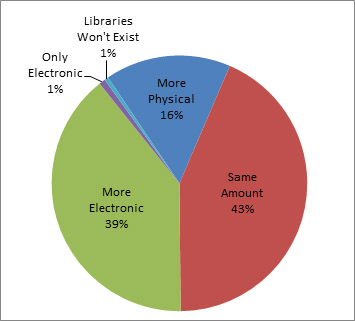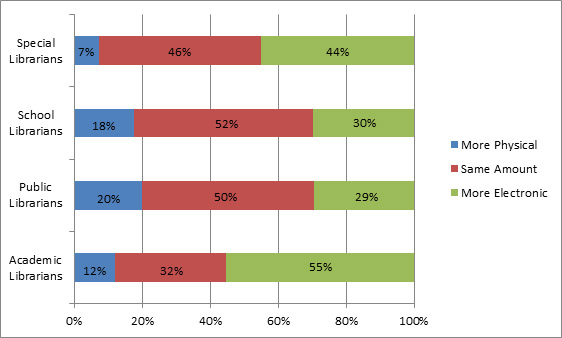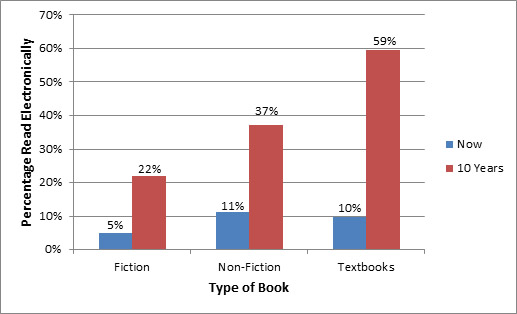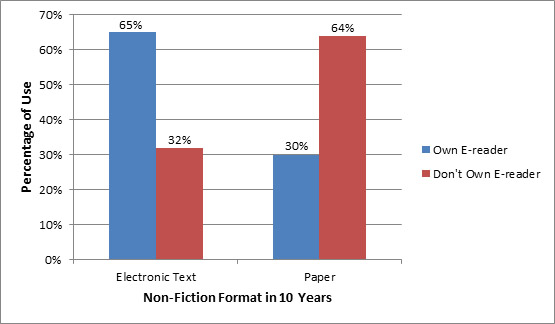With the emergence of more and more electronic reading devices, many people are discussing what this new reading method means for print formats. The Library Research Service’s (LRS) recent 60-Second Survey: The Future of the Book asked respondents what they thought of electronic and print formats and how those formats might change their reading habits in the future. Many respondents (71%) also left comments, which were analyzed according to 6 themes that emerged addressing various influences on format (see the first in this Fast Facts series, The Future of the Book, Part 1: Cost and Technological Advantages of Paper and Electronic Formats, for more information on the comment analysis).
This Fast Facts takes a closer look at what survey respondents said about the existence of multiple formats, the role content plays in determining format, the emotional and aesthetic aspects of paper books, and the influence of time and generation. Also analyzed are their responses to some of the survey questions, with particular attention paid to how the type of library where respondents work and whether they own an e-reader affected their responses.
Chart 1
60-Second Survey: The Future of the Book
Library Circulation in 10 Years
Percentage of Types of Materials

Multiple Formats
When asked what they thought about the future of the paper book, almost two-thirds (63%) of survey respondents reported that books would never disappear, and about 1 out of 10 (11%) foresaw their eventual demise after more than 100 years. In the meantime, paper books are left to compete with the growing number of electronic books appearing on the market.
Almost half (46%) of survey comments suggested that multiple formats for reading would coexist successfully in some way, citing electronic books as an alternative to, rather than replacement of, paper. In fact, when asked what they thought libraries would circulate in 10 years, 2 out of 5 respondents (43%) answered an equal number of physical and electronic resources, the most popular response. Nevertheless, the trend toward incorporating more electronic materials is apparent. Forty percent of respondents predicted that libraries would circulate more electronic than physical resources or only electronic materials in 10 years, with less than half as many (16%) anticipating circulation of more physical resources (see Chart 1).
“Like all communication formats, change is constant and new formats continue to evolve. Different formats work for different audiences and purposes. Paper will continue to work best for some types of reading and some audiences, although eventually some form of e-book will be the predominant format.”
Owning an E-Reader and Multiple Formats
As might be expected, owning an e-reader influenced what survey respondents thought about the future of library circulation. Although a plurality of respondents from each camp (41% e-reader owners, 44% non-owners) agreed that libraries would circulate about the same amount of physical and electronic materials, the more telling numbers are in the responses to “more electronic” or “more physical” materials. Respondents who owned e-readers (46%) were more likely than non-owners (38%) to anticipate higher circulation of electronic materials, while double the percentage of non-owners (17%) as owners (8%) predicted higher circulation of physical materials.
Library Type and Multiple Formats
The type of library where respondents work also affected their views on future library circulation. Public and school library staff gave similar responses to the types of materials libraries would circulate in 10 years, with half anticipating an equal number of electronic and physical materials. In contrast, only a third of academic librarians expected to circulate an even number of each format.
Instead, the majority of academic librarians (55%), more than any other type, predicted more electronic materials, while just under a third (30%) of public and school librarians said the same. Special librarians’ predictions were split more equally, with nearly half (46%) expecting to circulate the same amount and slightly fewer (44%) anticipating more electronic materials (see Chart 2).
Chart 2
60-Second Survey: The Future of the Book
Percentage of Library Materials Circulated in 10 Years
Predicted by Different Types of Librarians

Content is King
A number of respondents emphasized that the information itself is more important than how it is packaged; nevertheless, the nature of that information can influence its presentation. Nearly 1 out of 5 (18%) comments indicated that content may be the most influential factor in dictating the preferred format for various genres and types of materials.
“If a book contains something that interests a significant number of people it will be published and ‘read,’ regardless of format, and regardless of whether ‘reading’ actually means reading, viewing, listening, or participating, or all four.”
Two survey questions addressed the topic of content driving format choice. Respondents noted which format they currently used to read fiction, non-fiction, and textbooks and then indicated their anticipated use in 10 years. Only 1 format showed little change: audio use of each type of material was expected to increase less than 1 percent.
In contrast, respondents indicated that their use of electronic formats to read fiction, non-fiction, or textbooks would escalate anywhere from 3 to 6 times the current percentages, while paper use would decrease accordingly. Paper was still the preferred format in the future for fiction and non-fiction, but a closer balance between it and electronic use supports the likelihood that multiple formats will coexist.
Within the predicted changes, the number of respondents who expected to read textbooks electronically jumped significantly, from 1 in 10 now to nearly 6 in 10 (59%) in a decade. Fiction and non-fiction saw substantial, though less dramatic, increases in anticipated use of electronic formats (from 5% to 22% and 11% to 37%, respectively) (see Chart 3).
Chart 3
60-Second Survey: The Future of the Book
Percentage of Fiction, Non-Fiction, and Textbooks
Read Electronically Now and in 10 Years

Owning an e-reader influenced whether respondents thought they would read fiction, non-fiction, and textbooks electronically in the future, though the discrepancy was least obvious in the latter category. In 10 years twice as many e-reader owners (65%) as non-owners (32%) anticipated reading nonfiction electronically, with nearly the exact opposite being true for paper format (see Chart 4).
Chart 4
60-Second Survey: The Future of the Book
Non-Fiction Format in 10 Years by E-Reader Owners and Non-Owners

Responses and comments indicated that survey respondents thought news or informational reading was most likely to lead the way in transitioning to electronic text, while pleasure reading would remain in print. One rationale suggested by respondents was that electronic textbooks could offer enhanced searching and reduced costs for students and revised editions would be simpler to produce. When it came to defending fiction in print format, respondents often cited more emotive reasons.
Emotional and Aesthetic Appeal of Paper Books
One out of 4 comments addressed the unique emotional or aesthetic appeal of paper books. Although not asked directly about it in the survey questions, these comments revealed a heartfelt, personal attachment to paper books for a variety of reasons.
“Who wants to read their kid a bedtime story using a Kindle? And what e-reader can simulate the experience of looking at a large hardcover art book with high-quality reproductions? I just don’t see how e-readers supplant the paper book in areas such as this.”
Frequently noted was the comprehensive sensory experience of reading, which includes holding, feeling, and smelling a paper book, and hearing the turning of the pages. Equally common was a reference to the pleasure of “curling up with a good book.” For many respondents, the comfort and familiarity of reading paper enhanced the enjoyment of the activity.
“The times, they are a-changing. The book in some form will always be around. We just may not recognize the form our grandkids or great-grandkids call a ‘book.’”
In addition to the emotional aspect, paper books also boast certain aesthetic qualities that e-readers have yet to mimic satisfactorily. For example, many respondents claimed that the superiority of print illustrations ensured that coffee table, art, and children’s books would remain in print rather than finding success in an electronic format.
Time and Generational Influences
Just over 1 out of 10 (12%) survey comments indicated that the emotional attachment or aesthetic preference could be a generational phenomenon that would fade with time, affecting format prevalence. This almost inevitable “change over time” has occurred before, most obviously in format changes for music and movies, some of which resulted in near complete transitions and others that were shorter lived. While paper books offer more durability to survive the e-reader invasion, some respondents predicted that their use eventually would be restricted to museum displays and collectors’ items.
“Electronic materials will continue to rise in popularity, and will eventually take on some format that we can’t even imagine now. Regarding a time frame, it won’t happen overnight. We’ll have time to prepare and adapt. Relax.”
A few respondents remarked that with constant developments and the unveiling of new devices, it was nearly impossible to predict how e-readers would look and function in a few years. Despite the uncertainty, younger generations are already accustomed to using electronic technology. Most comments predicted that the transition to electronic formats would coincide and accelerate with baby boomers’ retirement and tech-savvy youngsters’ emergence as a driving force in the market and the economy.
Conclusion
The debate over electronic versus print books continues to raise a variety of questions and opinions. Despite some conflicting views, however, a significant percentage of survey respondents agreed that in the future, multiple formats will coexist in some way and libraries will circulate an increasing number of electronic materials. The type of content may prove to be the most influential factor in determining format. Many foresee informational reading transitioning to electronic text and pleasure reading remaining in print, as numerous respondents feel an emotional tie to paper books. Generational differences also could impact format prevalence, but only time will truly tell how and why paper or electronic formats prevail.